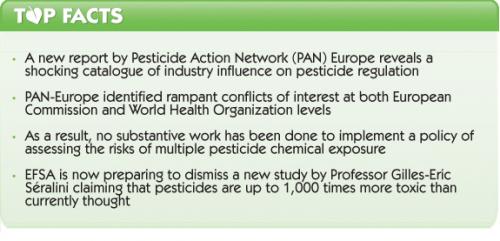A new report by Pesticide Action Network (PAN) Europe reveals that the European Food Safety Authority (EFSA) has consistently delayed, diluted and cancelled tougher policies on the health risks associated with human exposure to mixtures of pesticide chemicals. We know little about how small amounts of pesticides found on the foods we eat act as mixtures and interact with our bodies – even as European governments tell us that our food is safe. Worse still, more evidence is emerging that EFSA is siding with Big Ag and Big Food in a joint mission to bury worrying new research on toxicity associated with pesticide formulations. This regulator appears to have been well and truly captured.

Industry tactics exposed
According to PAN-Europe, there has been a “well planned and orchestrated attempt of industry to undermine policies meant to evaluate the toxicity of chemicals mixtures (cumulative risk assessment, CRA)”. Prompted by changes in US regulation, in 2005 the EU adopted Regulation 396/2005, Article 36 of which calls for harmonised pesticide maximum residue levels (MRLs) to be developed “using methods of assessing aggregate, cumulative and synergistic effects [i.e. CRA]”. Nine years later, EFSA has still not adopted CRA, leaving EU citizens “unprotected against the harms of mixtures of pesticides in food”.
Faced with this doubt, it is unsurprising that more and more people are electing to consume organic produce. According to German group FiBL and the International Federation of Organic Agricultural Movements (IFOAM), the agricultural land area that has risen to organic status in Europe is now 29% of the total, as compared with just 7% for North America, 10% in Asia and 18% in South America. This demand for organic produce is even more remarkable considering the media pressure exerted by the anti-organic movement.
Conflicts of interest identified
To tease out the reasons for this astonishing delay, PAN-Europe launched an investigation into the potential conflicts of interest of members of the EFSA Panel on Plant Protection Products and their Residues (PPR) and pesticide-related working groups, focusing on four broad areas:
- Their academic publishing record
- Declarations of interest (DoI) made under EFSA’s Policy on Independence and Scientific Decision-Making, along with other evidence of industry links
- Assessment of documentation related to decision-making processes, which was “severely hampered” by EFSA’s non-cooperation
- Potential dual roles held by EFSA experts, such as being active in industry-led research programmes for which they requested EU funds.
The picture that emerges from PAN-Europe’s analysis is not pretty, as shown in Figure 1.

Figure 1. Conclusions of PAN-Europe’s analysis of 27 experts used by EFSA in its work on cumulative risk assessment (CRA). Taken from the PAN-Europe report A Poisonous Injection.
Citizens at risk – industry smiling
PAN-Europe concludes that EFSA spent the first 6 years of its work on CRA dismissing the risk of multiple pesticide chemical exposure as irrelevant to human health. Even when forced to take CRA seriously by its boss, the Directorate-General for Health and Consumers (DG SANCO), “The EFSA pesticide panel refused to cooperate and in 2012 EFSA terminated the mandate of the panel because of the “lack of significant progress””. Furthermore, the report observes that “injection” of pesticide industry experts went beyond EFSA and extended to the World Health Organization (WHO): “Industry- linked scientists...could simply outnumber the other attendants in the WHO panel and impose the industry position on the WHO. Our research shows that out of the WHO planning group on CRA, 73% of the members...had industry links and conflicts of interest, while 5 out of the 6 authors that published the final WHO framework had strong industry ties.”
More of the same for EFSA
Regrettably, none of this is anything new for EFSA. As we have observed over several years, if there’s a Big Food position to be taken – whether on genetically modified (GM) crops and food, pesticides or food additives – EFSA can be relied upon to sit down at the industry piano and belt out the songbook with gusto. Most recently, EFSA played a shameful part in the smearing and eventual retraction of the important lifetime GM rat feeding study published by Professor Gilles-Eric Séralini’s group. Much to his credit, Prof Séralini isn’t one to take this lying down, and it wasn’t long before he returned to the table bearing a new headache for the pro-GM crowd.
How’s the headache?
His group’s latest paper, Major pesticides are more toxic to human cells than their declared active principles adds to the findings of an earlier study. Pesticide adjuvants, considered inert by regulators and many scientists, are responsible according to Séralini et al for an enormous increase in toxicity over and above the supposed active ingredient alone.
Confetti time
EFSA’s response? “It looks like that, in this paper, the test design is very much targeted towards provoking an expected effect, so no reason for a ‘crisis-intervention’,” declared an EFSA spokesman – heralding the “outraged screeches and acres of scientific-looking confetti” that we predicted some months ago.
In the meantime, increasing numbers of scientists are adding their names to a call for reinstatement of Séralini et al’s 2012 rat feeding study. This one looks set to run and run.
Time to go organic – if you aren’t already
Until we know more, it’s always good to minimise your exposure to pesticides. That means trying to cut out those foods that are likely to contain the highest residues of the least-friendly pesticides. There is no such EU list, but, based on more transparent US data, and especially the Environmental Working Group (EWG) Shopper’s Guide to Pesticides in Produce, you should perhaps make sure that leafy green vegetables and soft fruits are near the top of your organic food shopping list.








Comments
your voice counts
There are currently no comments on this post.
Your voice counts
We welcome your comments and are very interested in your point of view, but we ask that you keep them relevant to the article, that they be civil and without commercial links. All comments are moderated prior to being published. We reserve the right to edit or not publish comments that we consider abusive or offensive.
There is extra content here from a third party provider. You will be unable to see this content unless you agree to allow Content Cookies. Cookie Preferences